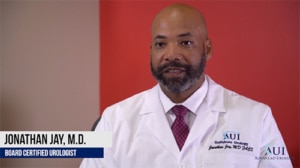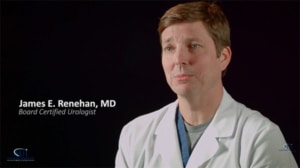KEY TAKEAWAYS:
- GPS Guided Biopsies offer greater accuracy in detecting and determining the type of prostate cancer, as they can pinpoint the growth more precisely than a regular biopsy.
- High-quality T3 MRIs, molecular biopsies, and patient follow-up allow urologists to monitor the cancer closely and make better-informed decisions about the need for aggressive treatment.
- Urologists use tools like rectal exams and prostate-specific androgen (PSA) tests to monitor the progression of prostate cancer and recommend surgery or radiation therapy if the cancer becomes aggressive.
Prostate cancer is one of the most common forms of cancer found in men. The likelihood of it forming in the walnut-shaped prostate organ increases with age. Luckily, there have been many major advances in how prostate cancer is diagnosed and treated. When it comes to diagnosing, board-certified urologist Dr. Jonathan Jay says, “First we must define where it is, how much of it exists within your prostate, and then what its behavior is like.”
Answering the where, how, and what is key to determining the type of prostate cancer and how to watch or treat it. Urologists are using advanced technologies to answer these questions. Urologists want to know how aggressive a cancer is when determining how aggressively they need to treat it. They can use a molecular biopsy and a high-quality T3 MRI to pick up on aggressive cancers. If an aggressive cancer is found, urologists can perform a more focused biopsy.
 This focused biopsy is called a GPS Guided Biopsy and it has some very important advantages over a regular biopsy. The cancer may exist in a very small portion of the prostate, especially early on. This small cancer can be missed during a biopsy just by a sampling error, leading to a diagnosis that may not give a completely accurate picture of the cancer. But with a high-quality MRI, a guided biopsy can pinpoint the growth and the urologist can detect and determine the type of cancer with greater accuracy.
This focused biopsy is called a GPS Guided Biopsy and it has some very important advantages over a regular biopsy. The cancer may exist in a very small portion of the prostate, especially early on. This small cancer can be missed during a biopsy just by a sampling error, leading to a diagnosis that may not give a completely accurate picture of the cancer. But with a high-quality MRI, a guided biopsy can pinpoint the growth and the urologist can detect and determine the type of cancer with greater accuracy.
When the cancer is detected with greater accuracy, the urologist can now follow it more closely and understand what type the doctor and patient are dealing with. The urologist can perform a biopsy on the cancer to look at and understand its genetics. If the genetics show that it is not very aggressive or growing, then the urologist may decide to watch the cancer, as treatment may not be necessary. MRI’s and patient follow up can be used to watch the growth to see if there are any changes that may require more aggressive treatment.
Along with MRI’s, the cancer can be monitored with rectal exams and prostate-specific androgens (PSA) tests. These tools offer insight into the patient’s specific prostate cancer and its progression. If it becomes aggressive, the urologist can recommend surgery or radiation therapy.
A diagnosis is the beginning of a patient’s cancer treatment. At the Advance Urology Institute, urologists like Dr. Jonathan Jay utilize recent advancements in prostate cancer biopsies to provide their patients with the most accurate diagnosis and best treatment options.
TRANSCRIPTION:
I’m Jonathan Jay, I’m a board certified urologist with Advanced Urology Institute.
One thing I’ve always said about prostate cancer, one you’ve got to be able to define where it is, how much of it exists within your prostate and then what its behavior is like.
So if we take that molecular biology and now we have MRI, T3 weighted MRI that can pick up aggressive prostate cancers and we do what we call GPS guided biopsy, a Euronav biopsy. So for instance, if I were sitting in this room and I’m the cancer, so this room is the prostate and I’m the cancer in the prostate, I could pass a needle through this room 15 times and miss me or just catch my baby toe. So I can miss the cancer just by sampling error. But if I had an MRI that said in this part of the room where I sit is an abnormality and it looks different than the other parts of the prostate and I focus on that, my ability to define and detect that cancer within that room is much higher. So we have the ability to do that. So not only did I detect the cancer in a much better way, but I have the ability now to follow the cancer. So if I biopsy that, look at the genetics of that cancer and it’s not very virulent, I can watch that cancer.
I got MRI which I can use to plot whether it changes in size or character. I can use the molecular biology to tell how fast it multiplies if it’s a virulent cancer. I’ve got PSA and I’ve got my rectal exam. So I’ve got three or four clinical tools for which I can follow that patient. We always talk about risk and benefit of treating any disease and we can watch this disease. If it shows that it’s being virulent or changing its character, then we can take the risk of having surgery or radiation. But we would not take that risk if it’s unnecessary if we saw something that was not changing much over time and a threat to the patient.
REFERENCES:
- “Prostate Cancer or Tumor – Diagnosis, Evaluation and Treatment.” https://www.radiologyinfo.org/en/info/prostate-cancer.
- “Prostate Cancer: Stages and Grades.” https://www.cancer.net/cancer-types/prostate-cancer/stages-and-grades.
- “Types of Cancer | CTCA | City of Hope.” https://www.cancercenter.com/cancer-types.





 Apart from occurring frequently among the elderly, ED is often a consequence of poor emotional and physical health. It is common in men with high cholesterol, diabetes, obesity, cardiovascular disease, hypertension, prostate disease, anxiety, damage from surgery or cancer, injuries, stress, depression, performance anxiety, relationship problems, alcohol use, smoking, and drug use. Typically, ED is caused by vascular disease (such as atherosclerosis) that prevents blood supply to the penis, a neurological disorder (like multiple sclerosis) that cuts transmission of nerve impulses to the penis, chronic medical disorders such as Peyronie’s disease, stroke and diabetes, trauma, and operations for bladder, colon and prostate cancer which may affect blood supply to the penis. These risk factors may work singly or in combination.
Apart from occurring frequently among the elderly, ED is often a consequence of poor emotional and physical health. It is common in men with high cholesterol, diabetes, obesity, cardiovascular disease, hypertension, prostate disease, anxiety, damage from surgery or cancer, injuries, stress, depression, performance anxiety, relationship problems, alcohol use, smoking, and drug use. Typically, ED is caused by vascular disease (such as atherosclerosis) that prevents blood supply to the penis, a neurological disorder (like multiple sclerosis) that cuts transmission of nerve impulses to the penis, chronic medical disorders such as Peyronie’s disease, stroke and diabetes, trauma, and operations for bladder, colon and prostate cancer which may affect blood supply to the penis. These risk factors may work singly or in combination.